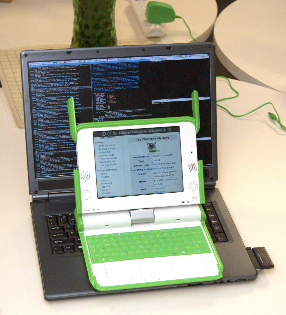Emulating the XO: Difference between revisions
(→Alternatives: Note LiveCd (April) kernel panic under kqemu on fc6 x86_64.) |
m (→Context: Wordsmithing. Added link to Category:Emulation.) |
||
| Line 10: | Line 10: | ||
== Context == |
== Context == |
||
One way to run oplc software is using an emulator on your pc. See [[Software]] and [[Getting started programming]] for other options |
One way to run oplc software is using an emulator on your pc. See [[Software]] and [[Getting started programming]] for other options. |
||
Compared to using a [[Developer Images|developer image LiveCD]], running XO disk images might be harder to set up, but easier to develop on. And compared to [[:Category:Installing_Sugar|installing sugar]], easier, but harder. |
|||
See [[:Category:Emulation]] for related pages. |
|||
== Alternatives == |
== Alternatives == |
||
Revision as of 00:19, 27 May 2007
Quick Start
To set up a "virtual XO", and get a taste of the XO software, see Quick Start.
Context
One way to run oplc software is using an emulator on your pc. See Software and Getting started programming for other options.
Compared to using a developer image LiveCD, running XO disk images might be harder to set up, but easier to develop on. And compared to installing sugar, easier, but harder.
See Category:Emulation for related pages.
Alternatives
| option | note | updated | hardware? | library? | writable? | development software? | network? | comments |
|---|---|---|---|---|---|---|---|---|
| LiveCd | April | yes | no | no | toolchain, Gnome | yes | Alternative Quick Start. Good for new developers. Problems: A. | |
| XO disk images: | no | yes | ||||||
| LATEST-STABLE-BUILD | ||||||||
| ...development.ext3.img | ~monthly | no | yes | yes | no | extra step | Quick Start for getting a look at Sugar. | |
| ...development-devel.ext3.img | ~monthly | no | no | yes | a little | extra step | ||
| LATEST | ||||||||
| ...development.ext3.img | ~daily | no | yes | yes | no | extra step | ||
| ...development-devel.ext3.img | ~daily | no | no | yes | a little | extra step | Good for new developers (requires some command-line comfort). | |
| FC6+Sugar | April | yes | yes? | yes | Full Fedora Softare Dev. | yes | 6GB (April version: no etoys) | |
| Installing Sugar | continuous | yes | yes | yes | your own | yes | Quite hard to do. |
Notes:
- hardware: Might your camera/video work. Is there even sound in the xo disk images?
- library: The olpc default library is included (english version). Ie, pretty text to web browse without having to get network.
- writable: With an .img, you can save things between sessions. With a .iso, your environment is the same each time you start.
- development software: are development tools included?
- network: does the network "just work"?
Problems:
- A: LiveCd (April) on fc6 x86_64, kernel panics under kqemu.
Todo:
- Maybe add columns: etoys?
Emulation for Development
The most common approach is to use QEMU with kqemu acceleration. See Quick Start for the basics. But we will use a different .img, one with a few extra utility programs. See OS images. Including the latest stable build.
Instead of qemu, you can run VMware, and there are addition options on a Mac.
Emulating the XO/Help and tips may help. Please report your experiences in User Feedback on Images. There is a Virtualization Common Room.
There are limitations with XO disk images.
Development using QEMU
If you wish to develop software on an emulated image, you will usually want a connection between your host and the laptop image.
You need a "*-devel*.img" image, rather than a standard (non-devel) one. The -devel image has extra software like sshd and wget.
Get network working on the laptop. See Using QEMU for Troubleshooting#Network. A simple echo ifup eth0 >> /etc/rc.local , run as root on the laptop, should do it. You should now be able to surf with the laptop's web activity. Under QEMU the Laptop image can see the host as IP address 10.0.2.2 .
Next, you have several alternatives:
- SSH using qemu -redir tcp:2222::22. (a good first approach)
- First-time setup
- Get the image's network working.
- Change the image's root password.
- Log into the image as root (no password needed yet!), type passwd , and then give it one. Complaints about "BAD" passwords won't stop things from working.
- Logging in as root is easy in qemu - you have a console window. Elsewhere...(? someone else will need to fill this in)
- Whenever you run qemu, add the argument -redir tcp:2222::22
- You can now log into the laptop image, from your real machine, using ssh. And you can use scp, etc.
- First-time setup
ssh -p 2222 root@localhost # simple ssh -o NoHostAuthenticationForLocalhost=yes -p 2222 root@localhost #avoids annoying warning
- SSH using a key. (if ssh passwords get annoying, you can try this)
- If you create an SSH server on your host and install a key on your Laptop image that has logon rights for that server, you can ssh from the OLPC to your host. This avoids password typing.
- Adding platform-specific instructions might be useful? MitchellNCharity 15:59, 21 May 2007 (EDT)
- Using a web server. (if you don't want to deal with ssh, and have a webserver)
- If you have a web server, you might simply download stuff onto the laptop using the laptops's web browser.
